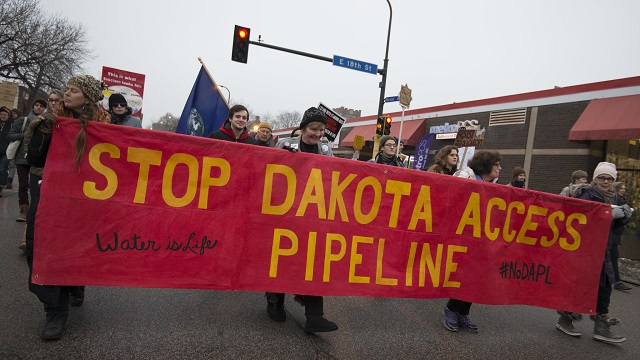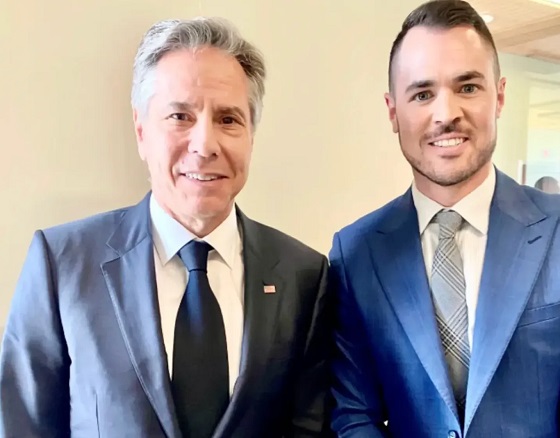Daily Caller
Lawsuit Aims To Hold Environmental Group Accountable For Pipeline Protests

 From the Daily Caller News Foundation
From the Daily Caller News Foundation
Marchers protest against the Dakota Access Pipeline
The recent spate of anti-Israel demonstrations at college campuses could cause déjà vu for North Dakotans, who endured the Dakota Access Pipeline protests in 2016. Like many of the campus protests, the pipeline protests were funded and fueled by big outside groups that showed little concern for the damaging impacts of their actions.
Now, a lawsuit being heard this summer is designed to hold some of these groups responsible for their actions. Energy Transfer, the owner and operator of the pipeline, is suing Greenpeace and other alleged instigators for $300 million for the damages sustained by the company as a result of these protests. The lawsuit claims that these environmental activists spent months spreading false information about the pipeline project and helped fund out-of-state agitators who attacked law enforcement and damaged property during the protests.
As it relates to the North Dakota controversy, the lawsuit alleges a Greenpeace misinformation campaign began with mass emails falsely claiming that the Dakota Access Pipeline would travel across the sovereign land of the Standing Rock Sioux Tribe, that it would destroy “sacred Native Lands,” and was being approved without proper environmental reviews.
Energy Transfer says none of the claims made by Greenpeace were accurate. It says the pipeline does not cross any Standing Rock land, and the company had made 140 different modifications to its planned route to avoid potentially impacting any culturally important sites. An independent review by the North Dakota Historic Preservation Office later concluded the pipeline affected no historic properties.
Furthermore, the pipeline was approved after years during which multiple environmental studies and reviews were conducted. Pipelines can actually play an important role in improving environmental outcomes because there is a greater likelihood of spills and leaks from other transportation methods like railroads, trucks and barges.
The lawsuit alleges that lies spread by Greenpeace attracted thousands of protesters to North Dakota who soon formed massive encampments.
Energy Transfer claims Greenpeace also helped provide nearly a half-million dollars and additional training to another group of protesters tasked with using violence to stop or delay the pipeline. Greenpeace allegedly continued to support these activities, even organizing fundraising drives across ten cities to collect supplies for the members of the Red Warrior Society. The lawsuit alleges that, in November 2016, members of the encampment raided Energy Transfer property, then lit fires and attacked police with grenades and flares.
In the aftermath of the protests, the suit alleges Greenpeace and its allies left with millions of dollars raised from the protests and their publicity. Meanwhile, North Dakotans were left with the bill to clean-up the environmental disaster of human waste, trash, and abandoned animals left in the encampments. And while the Dakota Access Pipeline was completed, Energy Transfer claims it lost significant amounts of money due to destroyed equipment, security costs, and project delays.
Energy Transfer’s lawsuit seeks to hold Greenpeace and others accountable for these alleged actions. Protesters and the groups that fund them have rights, but so do the individuals and companies who they unfairly malign and attack. The case could be an important reminder to organizations and protesters that free speech is constitutionally protected, but inciting and funding violent actions is not.
David Blackmon is an energy writer and consultant based in Texas. He spent 40 years in the oil and gas business, where he specialized in public policy and communications.
Daily Caller
Zelenskyy Under Siege As Top Aide Resigns After Home Raided In Major Corruption Scandal


From the Daily Caller News Foundation
Ukrainian President Volodymyr Zelenskyy’s chief of staff, Andriy Yermak, resigned Friday after his home was raided in an ongoing corruption probe that threatens to undermine Zelenskyy’s grip on power during wartime.
Ukrainian authorities on Friday raided the home of Andriy Yermak, Zelenskyy’s chief of staff and right-hand man, as part of a sweeping corruption probe investigating Zelenskyy’s possible involvement in a $100 million scheme to defraud the nation’s atomic energy company. Yermak’s resignation comes at a time when Zelenskyy is under increasing pressure to accept a U.S.-brokered peace deal to end Ukraine’s war with Russia.
The investigation has shaken Ukrainian confidence in Zelenskyy’s administration while Russian strikes continue to rock critical infrastructure. So far, Russia has not commented on the new proposed peace deal.
As a nonprofit, we are dependent on the generosity of our readers.
Please consider making a small donation of any amount here.
Thank you!
Zelenskyy first rose to power on an anti-corruption platform in the 2019 elections, which propelled him into the international spotlight. He has enjoyed a positive global reputation during the three-year war with Russia and has been hailed by numerous Western leaders as a beacon of democracy against autocratic Russia.
Zelenskyy has so far worked with the U.S. on the proposed peace agreement, but has also expressed major reservations about what it will mean for his country. In a public address on November 21, Zelenskyy said the plan puts Ukraine in the position of “either losing its dignity or the risk of losing a key partner.”
Despite the prospect of losing U.S. intelligence sharing and weapons if Ukraine doesn’t accept the deal, Zelenskyy has been shoring up European alliances and international support, most recently signing a deal with France to obtain 100 Rafale jets for its air force. The deal also included anti-air equipment, drones and other munitions.
The Ukrainian Ministry of Foreign Affairs did not immediately respond to the Daily Caller News Foundation’s request for comment.
Artificial Intelligence
Trump’s New AI Focused ‘Manhattan Project’ Adds Pressure To Grid


From the Daily Caller News Foundation
Will America’s electricity grid make it through the impending winter of 2025-26 without suffering major blackouts? It’s a legitimate question to ask given the dearth of adequate dispatchable baseload that now exists on a majority of the major regional grids according to a new report from the North American Electric Reliability Corporation (NERC).
In its report, NERC expresses particular concern for the Texas grid operated by the Electric Reliability Council of Texas (ERCOT), where a rapid buildout of new, energy hogging AI datacenters and major industrial users is creating a rapid increase in electricity demand. “Strong load growth from new data centers and other large industrial end users is driving higher winter electricity demand forecasts and contributing to continued risk of supply shortfalls,” NERC notes.
Texas, remember, lost 300 souls in February 2021 when Winter Storm Uri put the state in a deep freeze for a week. The freezing temperatures combined with snowy and icy conditions first caused the state’s wind and solar fleets to fail. When ERCOT implemented rolling blackouts, they denied electricity to some of the state’s natural gas transmission infrastructure, causing it to freeze up, which in turn caused a significant percentage of natural gas power plants to fall offline. Because the state had already shut down so much of its once formidable fleet of coal-fired plants and hasn’t opened a new nuclear plant since the mid-1980s, a disastrous major blackout that lingered for days resulted.
Dear Readers:
As a nonprofit, we are dependent on the generosity of our readers.
Please consider making a small donation of any amount here.
Thank you!
This country’s power generation sector can either get serious about building out the needed new thermal capacity or disaster will inevitably result again, because demand isn’t going to stop rising anytime soon. In fact, the already rapid expansion of the AI datacenter industry is certain to accelerate in the wake of President Trump’s approval on Monday of the Genesis Mission, a plan to create another Manhattan Project-style partnership between the government and private industry focused on AI.
It’s an incredibly complex vision, but what the Genesis Mission boils down to is an effort to build an “integrated AI platform” consisting of all federal scientific datasets to which selected AI development projects will be provided access. The concept is to build what amounts to a national brain to help accelerate U.S. AI development and enable America to remain ahead of China in the global AI arm’s race.
So, every dataset that is currently siloed within DOE, NASA, NSF, Census Bureau, NIH, USDA, FDA, etc. will be melded into a single dataset to try to produce a sort of quantum leap in AI development. Put simply, most AI tools currently exist in a phase of their development in which they function as little more than accelerated, advanced search tools – basically, they’re in the fourth grade of their education path on the way to obtaining their doctorate’s degree. This is an effort to invoke a quantum leap among those selected tools, enabling them to figuratively skip eight grades and become college freshmen.
Here’s how the order signed Monday by President Trump puts it: “The Genesis Mission will dramatically accelerate scientific discovery, strengthen national security, secure energy dominance, enhance workforce productivity, and multiply the return on taxpayer investment into research and development, thereby furthering America’s technological dominance and global strategic leadership.”
It’s an ambitious goal that attempts to exploit some of the same central planning techniques China is able to use to its own advantage.
But here’s the thing: Every element envisioned in the Genesis Mission will require more electricity: Much more, in fact. It’s a brave new world that will place a huge amount of added pressure on power generation companies and grid managers like ERCOT. Americans must hope and pray they’re up to the task. Their track records in this century do not inspire confidence.
David Blackmon is an energy writer and consultant based in Texas. He spent 40 years in the oil and gas business, where he specialized in public policy and communications.
-

 Alberta3 hours ago
Alberta3 hours agoFrom Underdog to Top Broodmare
-

 International1 day ago
International1 day agoAfghan Ex–CIA Partner Accused in D.C. National Guard Ambush
-

 Crime2 days ago
Crime2 days agoFBI Seizes $13-Million Mercedes Unicorn From Ryan Wedding’s Narco Network
-

 Energy1 day ago
Energy1 day agoPoilievre says West Coast Pipeline MOU is no guarantee
-

 Crime2 days ago
Crime2 days agoB.C.’s First Money-Laundering Sentence in a Decade Exposes Gaps in Global Hub for Chinese Drug Cash
-

 International2 days ago
International2 days agoTrump orders 500 more troops to reinforce D.C. after Guard shooting
-

 Artificial Intelligence2 days ago
Artificial Intelligence2 days agoTrump’s New AI Focused ‘Manhattan Project’ Adds Pressure To Grid
-

 armed forces2 days ago
armed forces2 days agoCarney’s ‘Shared Sacrifice’ Is a Lie. Only Veterans Are Bleeding for This Budget








